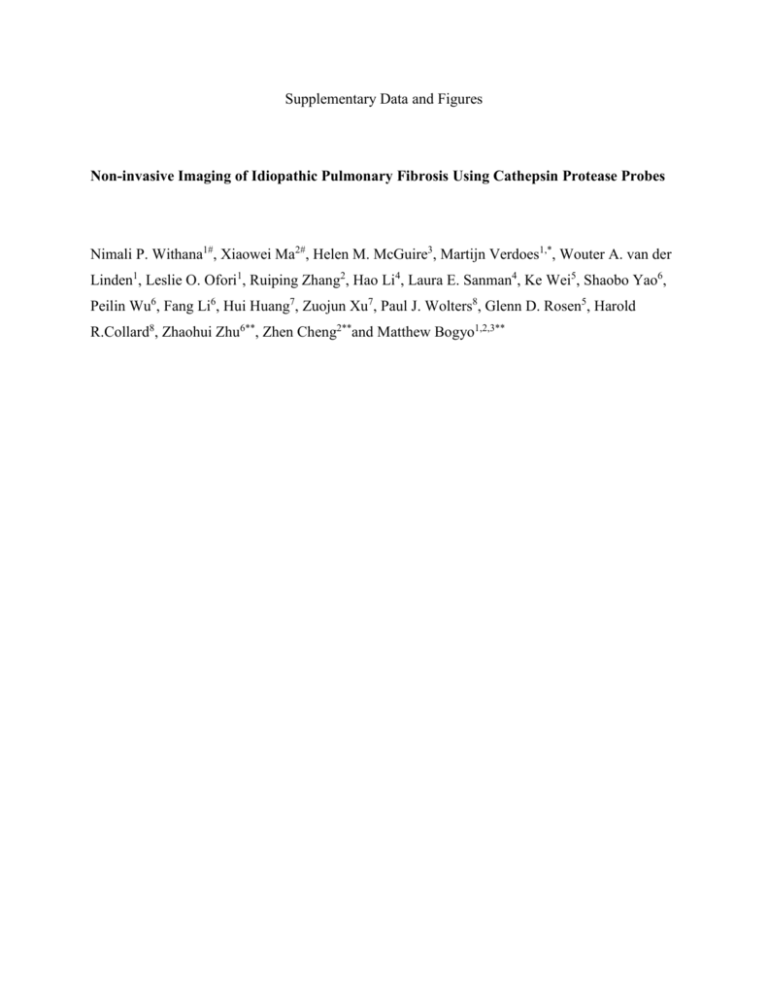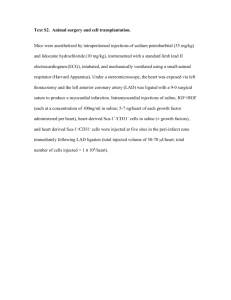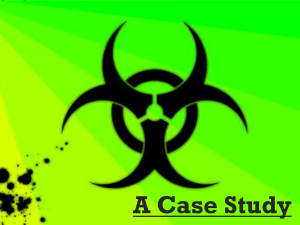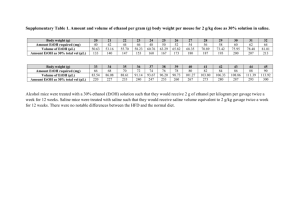Supplementary Data and Figures Non-invasive Imaging of Idiopathic
advertisement

Supplementary Data and Figures
Non-invasive Imaging of Idiopathic Pulmonary Fibrosis Using Cathepsin Protease Probes
Nimali P. Withana1#, Xiaowei Ma2#, Helen M. McGuire3, Martijn Verdoes1,*, Wouter A. van der
Linden1, Leslie O. Ofori1, Ruiping Zhang2, Hao Li4, Laura E. Sanman4, Ke Wei5, Shaobo Yao6,
Peilin Wu6, Fang Li6, Hui Huang7, Zuojun Xu7, Paul J. Wolters8, Glenn D. Rosen5, Harold
R.Collard8, Zhaohui Zhu6**, Zhen Cheng2**and Matthew Bogyo1,2,3**
Supplemental Methods:
Synthesis of the BMV101 probe
Compound 2. Boc-Lys-OH (1 g, 4 mmol) was dissolved in chloroform/DMF (2/1), trityl bromide
(2.84 g, 8.8 mmol, 2.2 equiv.) was added and stirred till the solution became clear. Triethylamine
(2.24 ml, 16 mmol, 4 equiv.) was added dropwise over 20 min and stirred for an additional 30
min. Methanol was added (5 ml) and the reaction mixture was stirred at 50 °C for 2 hr, before
being concentrated in vacuo. The crude was taken up in diethyl ether, washed with 10% citric
acid and water, dried over Na2SO4 and purified by flash chromatography (Hexane → 50% Ethyl
acetate in hexane).
Compound 3. To a solution of compound 2 (51.2 mg, 105 μmol, 1.4 equiv.), HBTU (39.8 mg,
105 μmol, 1.4 equiv.), DiPEA (45.5 μl, 261 μmol, 3.6 equiv.) in DMF was added GB111-NH2 ∙
TFA (50 mg, 73 μmol) and the reaction mixture was stirred overnight, before being concentrated
in vacuo. The crude material was purified by flash chromatography (Hexane → 40% Ethyl
acetate in hexane). Yield: 80 mg (73 μmol, quant.).
Compound 4. Compound 3 (10 mg, 9.6 μmol) was taken up in 1% TFA in DCM and stirred for
15 min, before a drop of water was added and the reaction mixture was coevaporated with
toluene (3x). The crude was taken up in DMF and NOTA (60 μmol, 6.25 equiv.), HBTU (68 mg,
180 μmol, 18.75 equiv.) and DiPEA (34.8 μl, 200 μmol, 20.83 equiv.) were added and the
reaction mixture was stirred overnight, before being concentrated in vacuo. The crude was used
without further purification.
BMV101 (5). Crude 4 (~0.96 μmol) was taken up in DCM/TFA (1/1) and stirred for 30 min,
before being coevaporated with toluene (3x). The crude was taken up in DMF and DiPEA (0.9
μl, 5 μmol, 5 equiv.) and Cy5-NHS (0.75 mg, 1 μmol, 1 equiv.) were added. After 2 hr the
reaction mixture was purified by HPLC (small column, 20-55% (20CV)). Yield: 0.91 mg (0.56
μmol, 58%).
Radiolabeling of BMV101
Cu-BMV101 was prepared by incubation of 10μL BMV101 (10mM) in 90μL sodium acetate
64
buffer (0.1M, pH 5.5) with 4 mCi of 64CuCl2 in 100μL sodium acetate buffer (0.1M, pH 5.5) at
37 ℃for 1 hour. After cooling to room temperature, the reaction mixture was analyzed by RPHPLC. The 64Cu-BMV101 was then purified by RP- HPLC with the mobile phase starting from
95% solvent A (di-water with 0.1% TFA) and 5% solvent B (acetonitrile with 0.1% TFA) for 3
min to 5% solvent A and 95% solvent B at 23 min. The eluted fractions containing 64CuBMV101 (retention time 18.9 min) were then collected and dried using a rotary evaporator. The
radiolabeling yield was 90% (calculated from the HPLC). The radiochemical purity, defined as
the ratio of the main product peak to other peaks, was determined by radio-HPLC to be >95%,
and the specific activity of the probe was determined to be 3-4 Ci/mmol. The 64Cu-BMV101 was
then reconstituted in 0.9% saline and passed through a 0.22 μm Millipore filter into a sterile vial
for animal PET/CT imaging.
68
Ga-BMV101 was synthesized immediately before the injection in a hot cell using a
manual method. Briefly, 1 mL 68GaCl3 eluent (370-555 MBq, pH 2.0-3.0) obtained from a
68
Ge/68Ga generator in a 1.5 mL centrifuge tube was added 93 μL sodium acetate solution
(NaOAc, 1.25 M) to adjust the pH range from 3.5 to 4.0. After addition of 20 μL of BMV101 (1
μg/μL in DMSO) to the mixed solution was heated to 37 °C for 30 min. After cooling to room
temperature, the reaction mixture was diluted to 5 mL and passed through a preconditioned SepPak C18 Plus Light Cartridge at a rate of one drop per second. The C18 cartridge was further
washed by water (0.5 mL × 2) to remove the excess 68Ga ion and other water soluble materials.
The resulting solution was analyzed by HPLC chromatography (Waters, USA). The mobile
phase starting from 5% solvent A (acetonitrile with 0.1% TFA) and 95% solvent B (di-water
with 0.1% TFA) for 5 min; ramped to 80% solvent A and 20% solvent B to 10 min; ramped to
100% solvent A and 0% solvent B to 15 min; the ratio was kept to 18 min; then ramped to 5%
solvent A and 95% solvent B to 20 min. The 68Ga-BMV101 was then reconstituted in 0.9 %
saline and filtered through a 0.2 μm Millex-LG filter (EMD Millipore) into a sterile vial before
use.
Radiopharmaceutical Preparation
68
Ga (half-life is 68 minutes, energy of β+ is 1.9 MeV) was eluted from the 68Ge/68Ga generator
(ITG, Germany) with 0.1 M HCl. The major radioactivity peak was collected as 2 mL final
volume and 20 mCi. Then, the pH was adjusted to 4.5 with 1.25 M sodium acetate buffer (pH
4.5). 10 μL BMV101 (1mM in DMSO) was added to the 68GaCl2 elution and the mixture was
incubated at 42 ºC for 30 minutes. The radiochemical yield was analyzed via RP-HPLC and thin
layer chromatography (iTLC, Bioscan, USA). The product was injected through C18 light
cartridge and was eluted with 200 μL ethanol. The elution was diluted with 3 mL of 0.9% NaCl
and passed through a 0.22 μm filter. For clinical study, this whole radiolabeling process was
done in a good manufacturing practice (GMP) environment. The stability of 68Ga-BMV101 in
mouse serum was evaluated by incubating 500 μCi 68Ga-BMV101 and 500 μL mouse serum for
3 hours. For the biodistribution assays in mice, a series of PET scans were performed at 1 h and
2 h respectively after intravenous injection of 3.7−7.4 MBq 68Ga-BMV101. For clinical
evaluation, 3 normal volunteer and 6 fibrotic interstitial lung disease (ILD) patients were injected
with 68Ga-BMV101 as 1.2 MBq per kilogram body weight. Whole-body PET images were
acquired at 2.5 hours after intravenous injection of 68Ga-BMV101. The scan
parameters were 140 kv, 35 mA, pitch 1: 1, thickness of 3 mm, spaced 3 mm, matrix512 × 512,
and FOV 70 cm. PET / CT examination was done using the Siemens Biograph 64 Truepoint
TrueV PET / CT. The standardized uptake value (SUV) of lung, liver, and muscle were
measured for semi-quantitative evaluation.
Flow Cytometry.
Cells obtained from the extracted BAL fluid were subjected to flow cytometric analysis.
Antibodies purchased from Biolegend were (F4/80 Cat#123119, Ly-6G Cat#127611, CD68
Cat#137013, CD11c Cat#117323, and CD11b Cat #101237). Cells were acquired using a LSRII
cytometer (BD Biosciences, San Diego, CA) and analyzed using FlowJo (Tree Star, Ashland,
OR). Intracellular cytokines were detected after 4 hours stimulation at 37oC (1 g/ml LPS, and
GolgiStop; 1:1000, BD Biosciences) using BD Biosciences intracellular staining kit according to
the manufacturer’s instructions.
Plasma Cytokine Detection with Luminex (Polystyrene bead kit).
Blood collected into tubes containing 200 ul EDTA/heparin were subjected to centrifugation at
2.8 K RPM RCF for 5 min and the supernatant removed, aliquoted into cryovials, and frozen at 80oC. Plasma samples were assayed with the Mouse 26 plex kit purchased from Affymetrix, and
performed in the Human Immune Monitoring Center at Stanford University according to the
manufacturer’s recommendations with modifications as described previously{RosenbergHasson, 2014 #153}. Results were shown by heatmap with values normalized by z-scores.
Lysate Labeling.
RAW cells were seeded in six-well plates (typically 1.5× 106/well) 24 h prior to harvest. Cells
were then washed once with PBS, scraped, and pelleted. Cells were then lysed in acidic buffer
(50 mM sodium citrate [pH 4.5], 0.1% CHAPS, 1% NP-40, and 4 mM DTT), snap-frozen in
liquid N2, and centrifuged at 4 °C for ten minutes. Supernatants were collected, and protein
concentration was determined using a BCA kit. An amount of 50 μg of total protein was then
aliquoted, followed by addition of the indicated probe from a 100× DMSO stock solution,
yielding a final DMSO concentration of 1%. Samples were incubated for 30 min at 37 °C and
then solubilized with 4× sample buffer. Proteins were resolved by 12% SDS-PAGE and scanned
using a Typhoon flatbed laser scanner (excitation 633 nm/ emission 670 nm). For the pH
dependence assay, citrate buffer was adjusted to the indicated pH just prior to lysis. Cells were
tested for mycoplasma contamination prior to conducting experiments.
Intact Cell Labeling.
RAW cells were seeded as above 24 h prior to labeling. Media were replaced, and a probe was
added from a 1000× DMSO stock solution, yielding a final DMSO concentration of 0.1%. Cells
were incubated for 1 h at 37 °C unless otherwise noted, washed once with PBS, scraped, and
pelleted. Cells were then lysed in hypotonic lysis buffer (50 mM PIPES [pH 7.4], 10 mM KCl, 5
mM MgCl2, 2 mM EDTA, 4 mM DTT, and 1% NP-40), snap-frozen, and centrifuged at 4°C.
Supernatants were then solubilized with 4× sample buffer, and 50 μg of total protein was
analyzed by SDS-PAGE as above. Cells were tested for mycoplasma contamination prior to
conducting experiments.
Live Cell Imaging.
RAW cells were seeded at a density of 100,000 cells in 35mm glass bottom dish (In Vitro
Scientific). Twenty-four hours later, cells were treated with 1M of each probe for five hours.
For the last 30mins, 100 nM of lysotracker-green (Molecular Probes, L7526) was added to the
cells. Cells were then washed three times with PBS, and phenol red-free complete medium was
added. Cells were imaged live at 40x using a Zeiss LSM 700 confocal microscope in both Cy5
and FITC channels. Cells were tested for mycoplasma contamination prior to conducting
experiments.
Tissue Labeling.
Tissues were sonicated in muscle lysis buffer (1% Triton X-100, 0.1% SDS, 0.5% sodium
deoxycholate, 4 mM DTT, PBS [pH 7.4]) and analyzed as above.
Collagen Assay.
Sircol collagen assay were performed according to manufacture instructions{Avasarala, 2013
#154}.
Topical application of activity based probe
Freshly isolated human lung tissues were frozen in OCT prior to sectioning. 5 μm thick sections
were fixed for 10 min in acetone at -20°C, and sections were blocked in 1% blocking reagent
(Perkin Elmer Cat#FP1020) for 1h and then stained for 1 hr with 1 mM BMV109 in PBS.
Sections were washed in PBS (3x5mins) and then stained with macrophage marker CD68
(1:1000 biorad MCA1815T) overnight at 4°C. Slides were washed, and the primary antibodies
were detected with Alexa Fluor 488–conjugated anti-rat IgG (Molecular probes) at room
temperature for 1 hours. Finally, sections were stained with DAPI and fluorescence images
acquired by confocal microscopy. Sections were imaged by tile scan and at 40× using a Zeiss
Axiovert 200 M confocal microscope in Cy5, FITC and Texas-Red channels. All images were
taken using a multitrack channel acquisition to prevent emission crosstalk between fluorescent
dyes. Single XY, XZ plane images were acquired in 1,024 x 1,024 resolution. Images were
processed as separate channels using Huygens deconvolution software or ImageJ and merged as
a single image. Mosaic images of fluorescence labeling were taken using 20x objective and
stitched using 15% overlay.
Microscopy.
OCT embedded lung tissue was sectioned at 5m and stained for macrophage marker CD68
(1:1000 AbD serotec Cat#MCA1957). Sections were imaged at 40× using a Zeiss Axiovert 200
M confocal microscope in both Cy5 and FITC channels. Human fibrotic lung tissue samples
were fresh frozen and embedded in OCT. Frozen tissue sections 5m were laid over glass slides
and stained for macrophage marker CD68 (1:1000 CD68 biorad MCA1815T followed by
secondary antibody with Alexa 488, Invitrogen A21151). A solution containing BMV109 probe
1M was then applied on the tissue and incubated 1 hour at room temperature in PBS. The tissue
was then washed to remove nonbound material, and detectable label was visualized with a
fluorescence microscope 40× using a Zeiss Axiovert 200 M. The tissue sampling protocol was
approved by the institutional review board and all patients signed informed consent to allow
tissue analysis.
Biodistribution
After PET/CT imaging, the mice were anesthetized and sacrificed. All of organs were collected
and measured with a gamma counter. The uptake were calculated and calibrated with decaycorrection, and expressed as percent of injected dose per gram of tissue (% ID/g). After
radioactivity counting, the lungs, livers, hearts, kidneys and spleens were also imaged with IVIS
200 for fluorescence imaging.
Fig. S1 Labeling of raw cells with the fluorescent and PET imaging probes GB123, BMV109
and BMV101. SDS-PAGE analysis followed by flatbed laser scanning of total lysates generated
from (A) probe labeled intact RAW cells and (B) lysates labeled with the indicated
concentrations of GB123, BMV109 and BMV101 (C) Live cell images of RAW cells labeled
with the indicated probes (red) and lysotracker (green) to highlight the lysosomes. Scale bars
indicate 20m. The images are representative of three independent experiments. For full uncut
gel images for panels A and B see the supplemental information files.
Fig S2. Confirmation of the biological outcomes from bleomycin treatment at days 7 and 14. (A)
Whole body and lung weights for mice from the different treatment groups (saline vs
bleomycin). (B) Histological analysis of lungs. H&E and Masson’s Trichrome Stain and Sircol
Assay measuring the collagen content in the lungs of mice treated with saline or bleomycin.
Scale bars indicate 10m. **p< 0.005, ***p< 0.0001 by 2-tailed Student’s t-test. (C)
Immunofluorescence analysis of lungs from mice treated with BMV109 (red) and co-stained
with the macrophage marker CD68 (green). Scale bars indicate 10m. (D) BAL fluid from mice
to monitor activated macrophages during disease progression. Samples were analyzed by FACS.
**p< 0.05, ***p< 0.005 by2-tailed Student’s t-test.
Fig. S3. Confirmation of biological outcomes of bleomycin treatment at 7, 14 and 21 days. (A)
Whole body and lung weights of mice for the treatment groups (saline vs bleomycin), **p<
0.005, ***p< 0.0001 by2-tailed Student’s t-test. (B) Histological analysis of lungs. H&E and
Masson’s Trichrome Stain. Scale bars indicate 10m. (C) Immunofluorescence analysis of lungs
from mice treated with BMV109 (red) and co-stained with the macrophage marker CD68 (green)
and DAPI (blue). Scale bars indicate 10m.
Fig. S4. Correlation of optical and PET/CT data. Non-invasive optical images of the same mice
from figure 4 treated with saline or bleomycin (left) and corresponding ex vivo fluorescence
intensity from lung (right) for the different treatment groups. Error bars indicate mean + SEM.,
Day 7 (saline n=3; bleomycin n=5), Day 14 (saline n=3; bleomycin n=7) and Day 21 (saline n=3;
bleomycin n=8). *p < 0.05, **p< 0.005, ***p< 0.0001 by 2-tailed Student’s t-test.
Fig. S5. PET/CT analysis on ABP 64Cu-BMV101 in murine model of IPF. (A) Bio-distribution
of the BMV101 probe for the treatment groups at Day 7, Day 14 and Day 21. (B) Plots of
average ratios (n = 3) of lung to liver and lung to muscle signals at the indicated time points.
Fig. S6. Topical staining of human tissues with BMV109. Images from multiple IPF (A) and
healthy control (B) human lung samples that were labeled with the optical probe BMV109 (red)
and co-stained with the marker for activated macrophages, CD68 (green). Samples were tile
scanned at high resolution to generate full images. Insets show regions of interest at higher
magnification. White scale bars on zoom images are 10m. Yellow and black scale bars on full
tiled images represent 1 mm. Additional patient sample data in Fig. 5.
Fig. S7. Application of the ABP 68Ga-BMV101 as a PET imaging probe. (A) Non-invasive 68GaBMV101 PET/CT scans of mice treated with saline or bleomycin at Day 7, two hours post probe
administration. Coronal (left), transaxial (top right) and sagittal (bottom right) images are shown
for representative mice from saline or bleomycin treated groups. (B) Corresponding
quantification of PET/CT intensity from lungs of all mice at Day 7 in the different treatment
groups. Error bars indicate mean + SEM., Day 7 (saline n=3; bleomycin n=3). *p< 0.05 by2tailed Student’s t-test. c) Bio-distribution of the 68Ga-BMV101 probe for the treatment groups at
Day 7.
Table S1 Values for pulmonary function test in patients with IPF, ILD and healthy controls.
Subject
number
Age
Sex
Control-1
32
F
Control-2
33
M
Control-3
47
F
IPF-1
64
M
IPF-2
61
IPF-3
Smoking
history
FVC
actual
FVC
predicted
FVC
%
ratio
DLCO
actual
DLCO
predicted
DLCO
% ratio
smoked
3.02
3.87
78.04
4.03
8.83
45.64
M
smoked
2.52
3.89
64.78
6.32
8.9
71.01
51
M
smoked
4.01
4.29
93.47
6.3
9.85
63.96
ILD-1
76
F
no smoke
-
-
-
-
-
-
ILD-2
67
F
smoked
2.02
2.46
82.11
-
-
52.30
ILD-3
60
F
no smoke
1.93
2.69
71.75
6.21
7.12
87.22
Abbreviations: FVC, forced vital capacity. DLCO, carbon monoxide (CO) diffusing
capacity.
Table S2 The signal-to-noise ratios for PET/CT imaging in mice from figure 4.
Lung-to-Liver
Lung-to-Muscle
Saline
Bleomycine
Saline
Bleomycine
DAY7
0.57±0.02
0.75±0.08
5.74±1.14
8.36±0.66
DAY14
0.62±0.08
1.00±0.07
6.34±1.20
10.01±1.31
DAY21
0.58±0.11
0.64±0.07
5.73±1.23
7.24±1.24
Table S3 The signal-to-noise ratios from the biodistribution studies from figure S5.
Lung/Liver
Lung/Musule
Saline
Bleomycine
Saline
Bleomycine
DAY7
0.70±0.05
0.84±0.06
5.99±1.10
9.00±0.72
DAY14
0.69±0.06
0.99±0.11
6.20±1.18
10.71±1.27
DAY21
0.69±0.07
0.81±0.11
6.19±1.16
8.04±1.23
Table S4 The signal-to-noise ratio for human PET/CT imaging from figure 6
Lung-to-Muscle
Lung-to-Liver
Normal
1.37±0.62
0.15±0.05
IPF
4.36±1.04
0.37±0.07
Supplemental Compound Characterization:
LC/MS analysis of BMV-101
LC-MS spectra of BMV-101 without 64Cu label:
RP-HPLC spectra for 64Cu-BMV101. a) radioactive channel b) HPLC 595 nm UV channel c) 4h
stability (in PBS) HPLC radioactive channel d) 4h stability (in PBS) HPLC 595 nm UV channel.
Radio-HPLC analysis of 68Ga-BMV101 showing the spectrum for the purified final product. The
RT (retention time) for 68Ga-BMV101 was 11.9 min under the gradient eluent conditions
outlined in the methods section.







